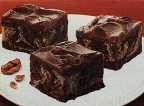It is a rare rat, indeed, that doesn't have a sweet tooth for chocolate. If your rat
likes chocolate and you suspect that your rat might be ill, or "off", offer it a
chocolate chip. If it refuses the treat, your rat could be sick and a vet check
is in order. If your rat never did like chocolate try a yogurt chip for the same
purpose.
Aminophylline
is derived from
Theophylline and both of these drugs are synthetic bronchodilators, that is,
their purpose is to open up constricted airways to the lungs to help ease
breathing in asthma, pneumonia, and bronchitis. Both of these drugs are prescribed
to our rats for the above mentioned ailments, but they are not without their adverse
side affects.
Theophylline is naturally found in
chocolate. Along with chocolate's
Theobromine and
Caffeine content,
a few semi-sweet chocolate chips could help your rat's breathing during respiratory
distress. It would stand to reason then, with Theobromine's affects on the
heart muscle and nervous system, and caffeine acting as a stimulant, that one
should take caution in giving rats chocolate when the rats are on a Veterinarian's
prescription for Aminophylline or Theophylline.
Not all chocolate is the same. If the package says "chocolate flavored", as did
the bag of Safeway brand chocolate chips that I bought for the rats, it's not
real chocolate. They tasted so artificial and waxy that I won't even eat them.
Don't buy Baker's chocolate either. It has the highest content of cocoa and the
lowest content of cocoa butter and sugar, and it's incredibly bitter. Semi-sweet
chocolate has the highest content of Theobromine while still being palatable. I
love semi-sweet chocolate myself so my rats have learned to share.
What Kinds of Chocolate
are There?
Depending on what is added to (or removed from) the chocolate liquor, different
flavors and varieties of chocolate are produced.
* Unsweetened or Baking chocolate is simply cooled, hardened chocolate liquor.
It is used primarily as an ingredient in recipes, or as a garnish. Too bitter,
tastes yucky.
* Semi-sweet chocolate is used primarily in recipes. It has extra cocoa
butter and sugar added. Best kind in my opinion.
* Sweet cooking chocolate is basically the same, with more
sugar for taste. Still good as a treat.
* Milk chocolate is chocolate liquor with extra cocoa butter, sugar, milk and
vanilla added. This is the most popular form for chocolate. It is primarily an
eating chocolate. Remember, contains lactose from the milk. Are your rats lactose
tolerant?
* Cocoa is chocolate liquor with much of the cocoa butter removed, creating a fine
powder. It can pick up moisture and odors from other products, so you should
keep cocoa in a cool, dry place, tightly covered. Cocoa also is bitter unless you
add sugar and water, or honey to it to make it palatable. Good for hiding medicines.
* Couverture is a special kind of chocolate. Couverture chocolate has more cocoa
butter than normal chocolate, anywhere from 34% to 39% for a really good brand.
This type of high quality chocolate is used as a coating for things like chocolate
truffles. Go ahead, spoil your rats rotten.
And don't forget the chocolate syrup, the chocolate sauce, the chocolate Boost/Ensure,
and the chocolate milk. All are good for mixing and hiding most medicines.
So What About the "Others"?
* White Chocolate is not chocolate. In order to be legally called "chocolate" a
product must contain cocoa solids. White chocolate does not contain cocoa solids,
that's why it's a smooth, off-white color. Real white chocolate is primarily
cocoa butter, sugar, milk and vanilla. There are some products on the market that
call themselves white chocolate, but are made with vegetable oils instead of
cocoa butter. Because white chocolate does not contain any cocoa solids it has no
benefits that semi-sweet chocolate does for respiratory distress. Makes a nice
rat treat though.
* Confectioner's chocolate isn't really chocolate at all, but a chocolate flavored
candy used by those who are impatient. It was created to melt easily and harden
quickly so it's great for chocolate covered fruit, and quick candies, but it doesn't
taste all that great. Around Christmas time grocery stores and bulk stores start to
carry Confectioner's chocolate for those who like to make their own Christmas Candy.
They come in round wafers and have different colors and flavors. Nutrition-wise
I would rather give my rats real chocolate rather then this stuff.
* Carob is the fruit of an evergreen tree that grows up to 15 meters. The fruit is a
pod 15 to 30 centimeters long and is classified as a legume. It looks like a lima bean
pod. Both pods and seeds are used. Carob is grown around the world in warmer climates
and is considered a highly nutritious food. Carob contains Vitamin A, B Vitamins,
several important minerals, and
it's abundant in protein. Carob has one third the calories of chocolate and is
virtually fat-free. Carob is used as a chocolate and coffee substitute
because it has none of the side affects of the two. Even though Carob tastes
something like chocolate it needs an aquired taste. Carob pods have been used to
treat diarrhea for centuries. Carob should be taken with plenty of water. Too much
Carob will produce the opposite effect and cause constipation. A good treat, BUT
IT'S NOT CHOCOLATE, and has none of the benefits that chocolate has for rats.
* Yogurt Chips are supposedly made with the same ingredients as real yogurt, and
have the same benefits as yogurt. I question that, but the rats lOVE them. Again,
they are not chocolate and do not have the benefits of chocolate. Yogurt chips, also
known as yogurt drops and yogies, can be purchased quite expensively from the small
animal supplies isles in pet shops, but I purchase mine as small chips in bulk form
at grocery and health food stores. Much cheaper that way, and the chips are just
paw-size for a rat.
* Other chips can be found in mint, peanut butter, raspberry, and butterscotch
flavors. Great treats....BUT THEY'RE NOT CHOCOLATE.
Chocolate For Sick Rats
Chocolate has a high
fat
content.
Chocolate has a
simple sugar
for quick energy.
Chocolate has
flavonoids
which have antioxidant activity to help fight free radicals.
Chocolate contains a compound known as Phenyethylamine which acts as a mood elevator
and anti-depressant.
Eating Chocolate makes the brain produce pain-killing opiates, according to a study
by a University of Michigan researcher.
All good reasons to indulge our rats in a little chocolate when they are not
feeling well.
After all is said and done, you're probably wondering how much chocolate I give
to my rats? Once every 3 weeks, my rats get 1 semi-sweet chocolate
chip each. Those that have respiratory illness get chocolate more often. Yogurt
chips are a more likely treat for every day training.
More Reading on Chocolate
for Rats
Chocolate and Rats
Like Chocolate for Ratties
Like Chocolate for Ratties II
Chocolate Toxicity?
Chocolate, An Effective
Means of Oral Drug Delivery in Rats
Ability of a Cocoa Product
to Correct Chronic Magnesium Deficiency in Rats
Cocoa-drinking rats' teeth were significantly healthier than those of their
straight-sugar counterparts
TOP OF PAGE
GO BACK TO GETTING TO KNOW YOU RATTY
HOME

This site is being created by Sandra Beasley
Copyright © 2002-2004
All Rights Reserved


